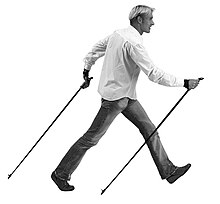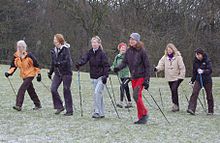Nordic walking
Nordic walking is an endurance sport in which fast walking is supported by using two sticks in the rhythm of the steps. It can be seen as a variant of the popular sport walking .
history
Nordic walking is defined as walking with specially designed sticks. Although runners, hikers and cross-country skiers had used the same concept as a training method decades earlier, the Finnish trainer Mauri Repo was the first to define Nordic walking as a sport. His 1974 work Hiihdon lajiosa appeared in a revised form in 1979 under the same title. The Nordic Walking concept was developed based on the summer training plan for skiers. This concept included the first explanations and instructions about the sport and exercises as well as anatomical and psychological reasons for why one should practice this sport.
In 1997 the first walking sticks were produced by the Finnish manufacturer Exel and brought onto the market. The technical term Nordic Walking was created in 1999 and became internationally known in the same year through an advertising leaflet.
General
The use of sticks turns walking into a workout that also uses the muscles of the upper body . Nordic walking is just as suitable for ambitious athletes as it is for untrained people. However, contrary to claims to the contrary, the joints are more stressed than when walking normally. According to a study by sports physicians at the hospital for sports injuries in Hellersen , the consumption of oxygen (and consequently the endurance load) with Nordic walking is approx. 5% higher when done correctly than with conventional walking when it is done without additional upper body movements.
Movement sequence
Nordic walking is a sport with cyclical movement. The right stick always touches the ground when the left heel hits the ground, the left stick when the right heel hits the ground . The sticks are held close to the body. The respective stick is inserted at an angle and flat to the rear; the pole should always be used below the body's center of gravity, i.e. in the step position on the vertical body axis. There are techniques in which the hands are constantly opened and closed. The front hand is opened immediately after the stick has been gently put down and closed again in the swing phase only after passing the large rolling hill ( thigh bone - greater trochanter ). The tip of the pole is loaded with the open hand by pressing on the loop.
equipment
Nordic walking sticks are made of light materials such as CFRP , CFRP- glass fiber mix or aluminum . CFRP dampens vibrations better than aluminum and is more stable. A removable rubber protection on the tips of the poles also absorbs impacts and reduces noise on asphalt. Hand straps are primarily used to transfer power from the arm to the pole and, secondly, to secure against slipping.
A stick that is too short or too long is a hindrance to functional movement. The following rule of thumb can be recommended for the length of the sticks: stick length = 0.66 × height. If in doubt, it is advisable to select a slightly shorter pole length than calculated so that there are no evasive movements in the shoulder joints. Many sticks can be adjusted in length using telescopic tubes.
The requirements for a running shoe and a walking shoe are similar. Compared to the jogging shoe, the heel area and the entire sole in the walking shoe are more rounded and should thus ensure a smooth roll .
criticism
- Various voices see Nordic walking as a trend triggered by accessory manufacturers.
- An additional point of criticism is the perception that the majority of people who do Nordic Walking do not have mastered the technique and only go for a walk “with dragging sticks” or do the sport with too low an intensity. However, it is positively noted from the medical side that many people at least move in this way.
German championship
In October 2010 the German Nordic Walking Championship in the half marathon took place in Altshausen in Upper Swabia with 194 participants.
Nordic walking parks
Large-scale Nordic walking parks now offer beginners and advanced skiers all over Europe the opportunity to practice their leisure sports. The mostly scenic and signposted route network with different degrees of difficulty can also be used by hikers and runners.
literature
- Overviews of literature from 2007–2008 and up to 2006
- Thomas Jöllenbeck, Christian Grüneberg: Healthy through Nordic Walking - Prevention or Myth? (PDF; 52 kB) In: Physiotherapie 2. 2008, pp. 23–26 , archived from the original on February 1, 2014 ; accessed on December 23, 2015 .
- Harald Lange: Optimal walking. The way to a coherent training concept and its application in practice. Spitta, Balingen 2006, ISBN 3-934211-96-8 .
- Ulrich Pramann, Bernd Schäufle: Nordic walking for beginners. Südwest, Munich 2005, ISBN 3-517-06862-4 .
- Johannes Roschinsky : Nordic Walking. Meyer & Meyer , Aachen 2004, ISBN 3-89899-020-6 .
- Andreas Wilhelm, Christian Neureuther , Rosi Mittermaier : Nordic Walking Practice Book. Droemer Knaur , Munich 2006, ISBN 3-426-64341-3 .
Web links
- Link catalog on Nordic Walking at curlie.org (formerly DMOZ )
Individual evidence
- ↑ Mauri Repo: Seuravalmentajan Perustiedot Hiidon Lajiosa. (PDF) (No longer available online.) 1979, archived from the original on January 1, 2014 ; Retrieved January 18, 2014 (Finnish). Info: The archive link was inserted automatically and has not yet been checked. Please check the original and archive link according to the instructions and then remove this notice.
- ^ Paula Warren: The History of Nordic Walking. International Nordic Walking Federation, May 18, 2013, accessed on January 18, 2014 .
- ↑ Thomas Jöllenbeck, Daniel Leyser, Claudia Classen, Melanie Mull, Christian Grüneberg: Nordic Walking - A field study on the myth of joint relief . In: J. Freiwald, T. Jöllenbeck, N. Olivier (Eds.): Prevention and Rehabilitation. Symposium report Bad Sassendorf 2006 . Strauss, Cologne 2007, p. 399–405 ( online ( memento of February 3, 2014 in the web archive archive.today ) [PDF; 2.8 MB ; accessed on December 23, 2015]). Nordic Walking - A field study on the myth of joint relief ( memento of the original from February 3, 2014 in the web archive archive.today ) Info: The archive link was inserted automatically and has not yet been checked. Please check the original and archive link according to the instructions and then remove this notice.
- ↑ Volker Höltke et al: Comparison of walking and Nordic walking in the moderate intensity range. (PDF; 71 kB) (No longer available online.) Department of Sports Medicine, Hospital for Sports Injured Hellersen, 2005, archived from the original on February 2, 2014 ; Retrieved January 18, 2014 . Info: The archive link was inserted automatically and has not yet been checked. Please check the original and archive link according to the instructions and then remove this notice.
- ^ Andreas Wilhelm, Christian Neureuther, Rosi Mittermaier: Nordic Walking Practice Book . Knaur, Munich 2006, ISBN 3-426-64341-3 .

